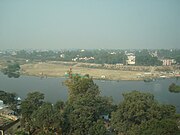Gomti River: Difference between revisions
No edit summary |
|||
| Line 2: | Line 2: | ||
The '''Gomti''', '''Gumti''' or '''Gomati River''' ({{lang-hi|गोमती}} ''Gomtī'') is a [[tributary]] of the [[Ganges River]]. According to [[Hindu]] mythology the river is the daughter of Sage [[Vashist]], and bathing in the waters of the Gomati on [[Ekadashi]] (the eleventh day of the [[Sanatana Dharma]]-[[Hindu calendar]]) can wash away one's sins{{ |
The '''Gomti''', '''Gumti''' or '''Gomati River''' ({{lang-hi|गोमती}} ''Gomtī'') is a [[tributary]] of the [[Ganges River]]. According to [[Hindu]] mythology the river is the daughter of Sage [[Vashist]], and bathing in the waters of the Gomati on [[Ekadashi]] (the eleventh day of the [[Sanatana Dharma]]-[[Hindu calendar]]) can wash away one's sins<ref name="RIB Expedition">{{cite web|title=Gomati River Expedition 2011|url=http://ribexpedition.com/expeditions/index.php/3-gomati-the-forgotten-river|accessdate=8 January 2013}}</ref>. According to the major religious work [[Srimad Bhagavatam]], the Gomati is one of the many transcendental rivers in India.<ref>{{cite web | url = http://srimadbhagavatam.com/sb/5/19/17-18/en1 | title = Bhaktivedanta VedaBase: Srimad Bhagavatam 5.19.17-18 | date = 2010-01-04| accessdate= 2010-01-04}}</ref> |
||
==Geography== |
==Geography== |
||
Revision as of 09:11, 18 January 2013
The Gomti, Gumti or Gomati River (Hindi: गोमती Gomtī) is a tributary of the Ganges River. According to Hindu mythology the river is the daughter of Sage Vashist, and bathing in the waters of the Gomati on Ekadashi (the eleventh day of the Sanatana Dharma-Hindu calendar) can wash away one's sins[1]. According to the major religious work Srimad Bhagavatam, the Gomati is one of the many transcendental rivers in India.[2]
Geography
The Gomti originates from Gomat Taal which formally known as Fulhaar jheel, near Madho Tanda, Pilibhit, India. It extends 900 km (560 mi) through Uttar Pradesh and meets the Ganges River near Saidpur, Kaithi in Ghazipur.

After 20 km from its origin, very small river Gaihaaee meets it. The river is a thin stream until it reaches Mohammadi Kheri(about 100 km from its origin),a tehsil of Lakhimpur kheri district, where it is joined by some tributaries like Sukheta, Choha and Andhra Choha. From here the river is well defined. Later other tributaries join this river. These are Kathina at mailani and Sarayan at a village in sitapur district. Another major tributary is the Sai River, which joins near Jaunpur. At the "sangam" of Gomti and Ganges, the famous Markandey Mahadeo temple is situated.
After 240 km the Gomti enters Lucknow, through which it meanders for about 12 km. At the entrance point water is lifted from the river for the city's water supply. 25 city drains in the Lucknow area drain untreated sewage into the Gomti. At the downstream end the Gomti barrage impounds the river converting it into a lake.
The cities of Lucknow, Lakhimpur Kheri, Sultanpur and Jaunpur are located on the banks of the Gomti and are the most prominent of the 15 towns located in its catchment area. The river cuts the Jaunpur city into two equal half and becomes wider in Jaunpur. It is located in india and it might be famous for many things
Pollution and degradation
Gomti river is under 'assault' at various points of its journey as it meanders through the 900-km stretch of rich alluvial plains of Uttar Pradesh. From industrial effluents to domestic discharge, the river becomes more of a flowing dumping yard for the 15 smaller and bigger towns, including Lakhimpur Kheri, Sitapur, Lucknow, Sultanpur and Jaunpur, in its catchment area.[3]
The major sources of pollution in the Gomti are:
- Industrial waste and effluent from sugar factories and distilleries.
- Domestic waste water and sewage from habitations.
The river collects large amounts of human and industrial pollutants as it flows through the highly populous areas (18 million approx) of Uttar Pradesh. High pollution levels in the river have negative effects on the ecosystem of the Gomti, threatening its aquatic life. On 25 July 2008, foundation stone for a sewage treatment plant was laid, which would have a capacity of 345 million litre effluents per day.[4]
Flooding
Regular flooding during the monsoon season leads to several problems when it recedes. Specially due to drying potholes and pits, which host diseases like Malaria and Dengue.
See also
References
- ^ "Gomati River Expedition 2011". Retrieved 8 January 2013.
- ^ "Bhaktivedanta VedaBase: Srimad Bhagavatam 5.19.17-18". 2010-01-04. Retrieved 2010-01-04.
- ^ "Aiming for a scrubbed clean look". The Times Of India. 2010-01-28. Retrieved 2010-01-28.
- ^ "Foundation laid for country's largest STP to clean Gomti in UP". 2008-07-25. Retrieved 2008-12-21.
Notes
- Sacred Rivers
- "Sewage kills thousands of fish in north Indian river". Babu Lal Sharma, Associated Press, August 22, 2003
- Markandey Mahadeo on Wikimapia
- Reference to Gomti River System
